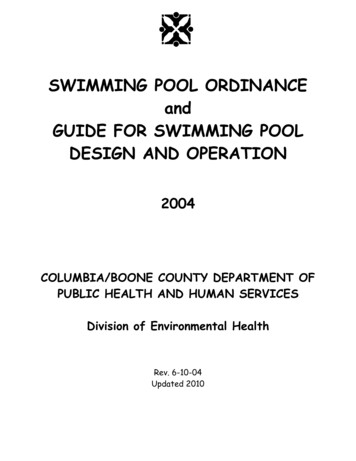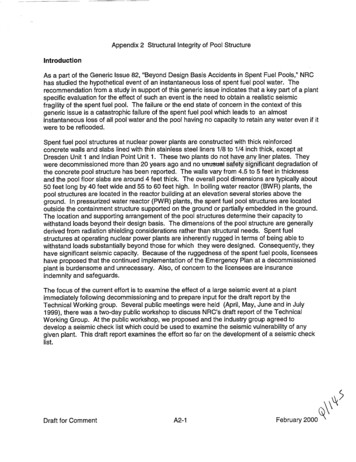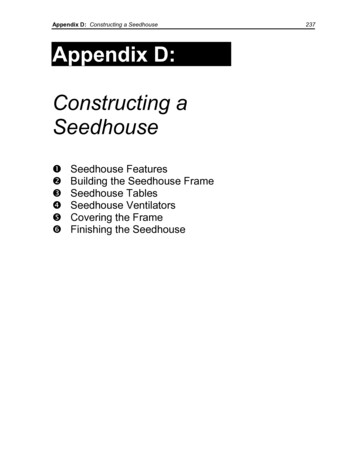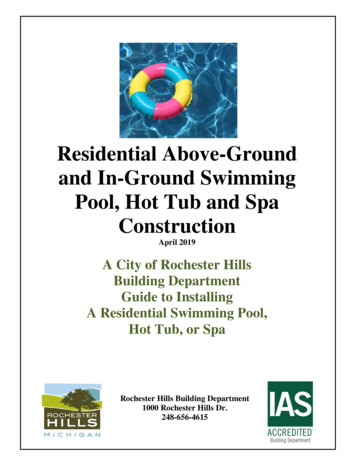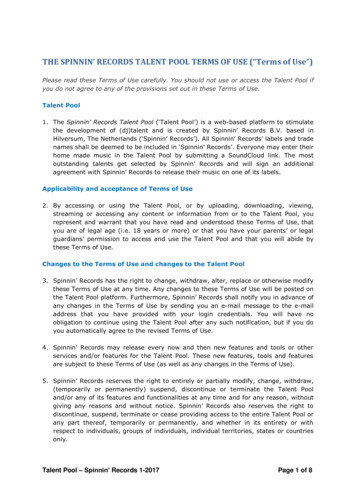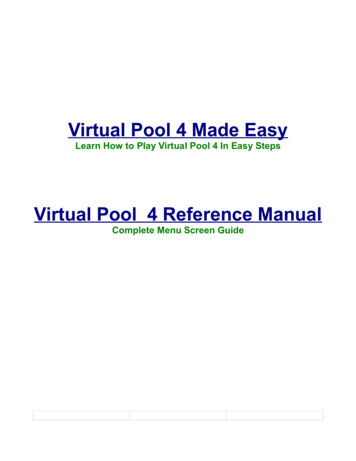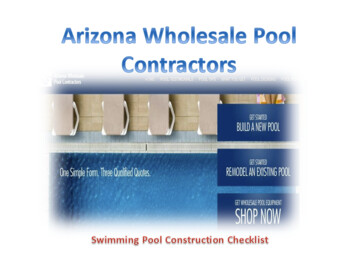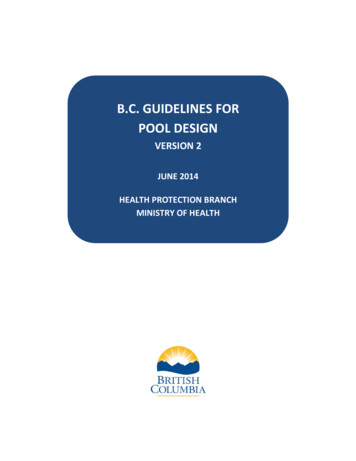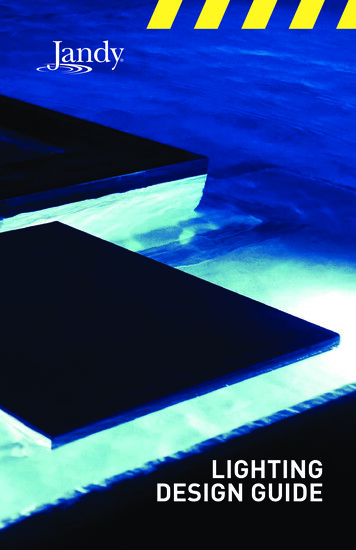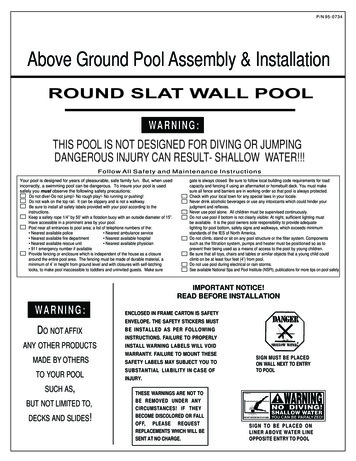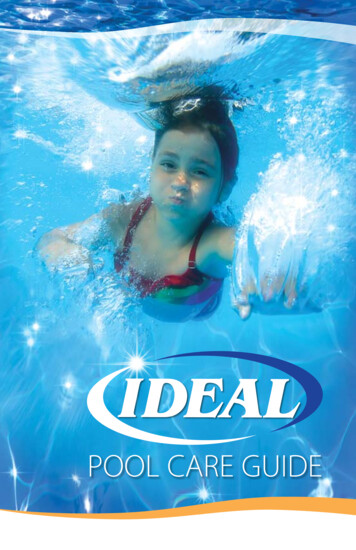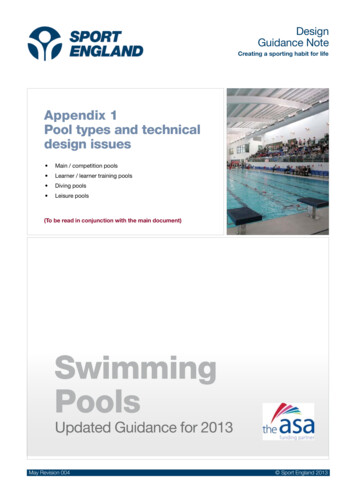
Transcription
DesignDesignGuidanceNoteGuidanceNoteSwimming PoolsCreating a sporting habit for lifeAppendix 1Pool types and technicaldesign issues Main / competition pools Learner / learner training pools Diving pools Leisure pools(To be read in conjunction with the main document)SwimmingPoolsUpdated Guidance for 2013April Revision004May Revision0041 Sport England2013 2013Sport England
Swimming PoolsDesignGuidance NoteMain / competition poolsGeneral criteriaThe following should be noted: Certified length of pool tank: For ASA/FINAcompetitions and high-level training in 25 mand 50 m pools, the end walls should beparallel and at right angles to both theswimming course and water surface.The actual length of the finished surfaces from0.3 m above and 0.8 m below the watersurface should be certified by a surveyorapproved by the ASA.Starting platform at the London 2012 Aquatic CentreThe certified length must not be less than thatrequired for the actual competition (i.e. 25.000m or 50.000 m) but with a minimum toleranceto achieve ‘fast swimming times’.The depth of the water can also affect thespeed that swimmers can attain. Pools usedfor swimming competition under FINA rules,require a minimum water depth of 1.35 mextending from 1.0 m to at least 6.0 m fromthe end wall for pools with starting blocks.Elsewhere a minimum depth of 1.0 m is required.However a depth of 1.8 m is preferred 2,increasing to 2.0 m minimum or 3.0 mpreferred for World and Olympic events.Dedicated competition pools may be set at aconstant depth.Recommended International standards are towork to a maximum dimensional tolerancebetween the finished wall surfaces of pooltanks of 0.030 m. This assumes that therewill be 2 no. 0.010 m thick timing touch pads(one at each end 1) and an allowableconstruction tolerance of 0.010/-0.000 m.However, the thickness of timing touch pads canvary from one manufacturer to another andtolerances may need to be adjusted accordingly.The timing touch pads should be rigidlylocated on the end walls to achieve thenecessary certification and to withstand thecontinuous pressure from swimmers duringtraining - see diagrams on page 6.For 25 m community pools, it is recommendedthat the 0.030 m tolerance is also used sothat timing touch pads can be added in thefuture for local competition. Width of pool tank: depends on the numberand width of swimming lanes and extramargins of water required for the two outerlanes to improve swimming conditions. Theminimum lane width is 2.0 m for 25 m pools.Competition pools used at regional, nationaland international levels should be providedwith lanes of 2.5 m width. Water depth: should not be less than 0.9 m inshallow water areas of 20 m and 25 mcommunity pools. However, where a learnerpool is provided and in larger pools, the depthshould be increased to a minimum of 1.0 m tofacilitate tumble turns.Colour of tank finish: white or pale bluefinishes are preferred as they have highreflectance factors. This makes it easier to seeswimmers below the water and to judge byeye the clarity of the water. Pool tank profile: should be considered inrelation to the range of activities to beaccommodated and whether movable floorsand bulkheads are planned (see page 5).3 m constant water depth at the London 2012 AquaticCentre which features a movable floor2 The ASA and CIMSPA (formerly the ISRM) stipulate a minimumdepth of 1.8 m for the teaching of shallow entry dives from thepoolside. See ISRM publication Diving and Jumping intoSwimming Pools and Open Water Areas which also has adviceon the use of starting platforms and the ASA Competitive StartAward. For the teaching of shallow dives where the freeboard isgreater than 0.38 m, the FINA standards for the depth of waterunder a 1 m platform should apply.1 If timing touch pads are proposed only at the start end andnot at the turning end, this should be agreed, beforeconstruction, with the Amateur Swimming Association (ASA)http:/www.swimming.org/asaMay Revision 004 1 Sport England 2013
Swimming PoolsDesignGuidance NoteFor safety, variations in water depths below0.8 m should be achieved through gradientsof 1 in 20 (5%). For variations between 0.8 mand 1.35 m, gradients should be no steeperthan 1 in 17 (6%) 3. Where pool depths continuedown to 1.5 m or 1.8 m the same gradientshould preferably be continued. See diagram fortank profiles, depths and gradients on page 5.They are an advantage for competitions andtraining, but are not required for fitnessswimming. They allow easier integration ofautomatic officiating equipment for competitiveevents.For occasional competition use, temporarystarting platforms and turning boards shouldbe used.The 1.35 m depth line should be conspicuouslymarked on the pool floor by a contrasting lineto identify the start of deeper water.The ASA advocates that turning boards shouldbe installed during lane swimming sessions forfitness in all lanes but particularly in the fast andmedium pace lanes.Dedicated competition pools may be set at aconstant depth of 1.8 m preferred, or 2.0 mminimum for World or Olympic competition(see FINA handbook). Pool edge detail: a ‘deck level’ edge is themost effective and attractive option. This allowspool water to constantly overflow the edges ofthe pool tank and drain into a continuouschannel set into the pool surround. The channelcan be positioned at the pool edge or set backbehind a tiled margin of approximately 0.30 m. Lane markings: positioned on the pool tankfloor and end walls in the centre of eachswimming lane, they help swimmers judge theend of the pool tank when turning and arerequired for competition. They should be darkblue or black, contrast with the pool tank finish,and be set out to meet ASA/FINA standards. Vertical access steps and ladders: shouldbe recessed flush with the pool tank wallsand positioned at each end of the pool tankabout 1.0 m from the end walls. Extra stepscan be provided mid-way along the sidewalls.For 50 m pools, additional steps will berequired at mid-point and adjacent to anybulkhead parking locations. For diving tanks,steps should be positioned to allow divers toswim away from rather than towards thediving boards after a dive. Rest ledges: are useful where the water depthis greater than 1.8 m. They should be fullyrecessed into the finished surface of the tankwall at a water depth of not less than 1.2 m. Underwater lighting: can contribute to apleasant atmosphere and if of sufficientintensity 4 can help staff see people beneaththe water more easily. Lighting should only beinstalled in the sidewalls of the tank. See SportEngland’s new ‘Artificial Sports Lighting’Design Guidance Note. Underwater windows: are useful forsurveillance in those pools used for serioustraining and competition. These are normallyinstalled in the side walls of the tank. Howeverthey can be installed in the end walls if morethan 0.8 m below the water surface to avoidinterfering with turning.Deck level edge pools have advantages overthe older freeboard (scum channel) pools:OOOOOOOOOOEasier pool entry and exit, particularly fordisabled peopleImproved surveillance of the pool tank fromthe poolsideImproved air movement across the surfaceof the pool, enabling more effective removalof airborne chemical pollutantsImproved surface draw-off removingpollutants from the water surface moreefficientlyReduction in water turbulence, improvingconditions for swimmers in the outer lanesand people learning to swim.The deck level edge must be designed to allowswimmers to obtain a grip and also have adark coloured edge demarcation to allow theedge of the water to be more easily seen byswimmers and those on the pool surround. Raised pool ends: provide a clearly visiblevertical surface in deck level pools for tumbleturns to be safely executed and remove theneed for separate turning panels. The endsshould be 0.3 m above the water level andincorporate a hand grip. Where the water depthpermits they can be used to teach diving.4 CIE 62 suggests that an underwater lighting intensity of 1000- 1500 lm/m2 would be required to help reduce the veiling effectof reflected light on the water surface.3 BS EN 15288:1:2008 - Sport England have adopted the‘preferred’ gradients (rather than the ‘minimum’ gradients) astheir standard.May Revision 0042 Sport England 2013
Swimming PoolsDesignGuidance NoteLayouts and dimensions10 - 20 mFor water depths of 0.8 m or less, changes in pooldepths should be achieved with gradients of 1 in 20(5%). For water depths between 0.8 m and 1.35 m,changes in pool depths should be achieved withgradients no steeper than 1 in 17 (6%). Where pooldepths continue down to 1.5 or 1.8 m the samegradient should preferably be continued. See diagramfor tank profiles, depths and gradients on page 5.7m7 x 10 - 20 m learner pool **20 m8.5 m20 m 4 lane community pool **4 lane50m25 m8.5 m25 m 4 lane communityswimming pool **4 lane10.5 m25 m 5 lane communityswimming pool **5 lane50 m training pool - Width varies depending on need.Minimum width of 10 m - 4 lanes x 2.5 m or 5 lanes x 2 m **25 m recommended communityswimming pool **13 mside margin (or additional lane)6 lane8 lanes25 m25 m County Standard pool **17 m8 laneside margin (or additional lane)50 m FINA international competition pool **Pool TypeLength(m)Width(m)No. ofLanesLaneWidthSide Margin Depth(m)(m)Learner Pool **Community 20 m **10.00 - 20.0020.00N/A0.250.60 - 0.900.80 - 1.00/1.5025.002.000.250.90 - 1.50 min1.00 - 2.00 prefCompetition Short Course Championship Training PoolASA National Competition 25.00 *25.00 *50.0050.00 *245456684-882.002.00Community 25 m **1.00 - 1.80 min1.801.00 - 1.80 min1.00 - 1.80 min2.00 pref50.00*82.002.002.002.25 ***2.502.500.500.500.500.50FINA National Competition .0021.0021.00FINA International Competition 50.00 *25.0082.500.20 min0.50 pref2.501.35 min2.00 pref2.00 min*For competition pools, an allowance should be made for automatic timing touch pads and for the finished dimensionbetween surfaces of the timing touch pads / walls to be certified by an approved surveyor (see page 6).** Provision of a movable floor allows the pool to be put to multi-purpose community use.*** Standard timing pad widths are 1.9 m (2 m lanes) or 2.4 m (2.5 m lanes). 2.25 m wide lanes require bespoke timing panels. Spectator and competitior seating provision appropriate to the level of competition should be discussed and agreedwith the ASA / FINAMay Revision 0043 Sport England 2013
15 m to cross line(for 50 m pools only)End wall targetSwimming PoolsDetail 1 DesignDetail 2Guidance NoteDetail 3ASA/FINA competition pool dimensional requirementsYRaised pool enTiming touch pad JLane ropes15 m to cross line(for 50 m pools only)Detail 2BKey planDepth to centreof end walltargetEnd wall targetDetail 1ThmaceswlanRaised pool endThe lanemarkings arecentred on eachswimminglane at E centres15 m to cross line(for 50 m pools only)X2 (between tiled finishes)15 m to cross line(for 50 m pools only)X1 (between timing pads)Detail 3CAFH15F m to cross line(for 50 m pools only)EX2 (between tiled finishes)Detail 1Elevation of end walls15 m to cross line(for 50 m pools only)X1 (between timing pads)0.3 mLanemarkingDE/2Detail A2RacinLanemarkingsE/2Detail 2ERacing Lane widthKey planCross linesE/2Hsee tableCross linesDetail 3 (for 50 m pools only)Detail 3 (for 50 m pools only)ASAAll sizes in metresASAsizes in metresPool Length All(minimumcertified length)Pool Length (minimum certified length)1Length(with maximum tolerances)tolerances) 1Pool Length Pool(withmaximumPool WidthPool WidthWidth of lane markings, end lines, targets25.00X225.03X2Aof end wall targetsWidth of laneLengthmarkings,end lines, targetsDepth of centre of end wall targetsLength of endwalltargetsLengthof lanemarker cross lineWidth of racing lanes (Pool widths 8.5-17 m)Depth of centreof end wall targets 3X1Y3Width of racing lanes (Pool width 18 m)Length of lanemarkercrossline19 m) 3Widthof racing lanes(Pool width2B2C2D28.50 / 10.50 /Y13.00 / 17.000.200.50 20.80B2.00E2.125D2.1255-18 m) 3Width of racing(PoolNo. oflaneslanes (Poolwidth 8.5widthm)F2.00G4No. of lanes (Pool width 10.5 m)Width of racinglanes (Pool width 19 m) 3GGWidth of racing(Pool21 m / 25Outer lanesmargin (Poolwidths widths8.5 m / 10.5 m)H m)Outer margin (Pool widths 13-21 m)Distance fromcross line to end wallOuter margin (Pool width 25 m)No. of lanes Timing(Poolwidthtouchpads 8.5 m)HHJ250.03558-50.0025.03 50.0321.00 /10.5025.00 /17.000.250.20 0E8F12Dimensions A, B, C, D, F and J are subject to a /- 0.05 m tolerance.G450.0321.00 5 -0.502.0042.002.25--2.502.500.502.002.00--8 / 102.502.408Lane widthsof 2 m relateto 17poolsm)used for training purposes.Outer margin5 (Poolwidths8.5mm/wide10.5H50.0317.00 / 18.00 /19.00 / 21.00 / 25.000.251.001This assumes2 no.10 mm m)timing touch pads and a maximum 10 mmNo. of lanes (Poolwidth10.5Gconstruction tolerance (see5page 5).No. of lanes (Poolwidths 17-25 m)3ASA 25 m or 50 m pool.FINA50.002.125 -2.40 6ASA50.002.00 42.5061.90 G0.300.300.800.25 E0.5025.00 FINA17.00 / 18.00 /8.50/19.00 / 21.00/ 25.0013.00 /0.25C2EWidth of racing lanes (Pool widths 21 m / 25 m)E 3Width of racinglanes (Pool widths 8.5-17 m)1No. of lanes (Pool widths 17-25 m)50.00A0.30EDistance from cross line to end wallASAX10.25--88 / 10--Outer margin6 (Poolwidths13-21m) than 2.0 m and 2.5 m (e.g. 2.125Hm or 2.25 m) will require bespoke0.50 manufacture.Timing touchpads for lanewidths other0.500.50Outer margin (Pool width 25 m)H2.50Timing touch padsJ2FINA 50 m pool.1.9062.402.5062.401This assumes 2 no. 10 mm timing touch pads and a maximum 10 mm construction tolerance (see page 5).2Dimensions A, B, C, D, F and J are subject to a /- 0.05 m tolerance.ASA 25 m or 50 m pool.Lane widths of 2 m relate to 17 m wide pools used for training purposes.3456FINA 50 m pool.Timing touch pads for lane widths other than 2.0 m and 2.5 m (e.
50 m training pool - Width varies depending on need. 25 m County Standard pool ** 25 m recommended community swimming pool ** 25 m 5 lane community swimming pool ** 25 m 4 lane community swimming pool ** 20 m 4 lane community pool ** 7 x 10 - 20 m learner pool ** Pool Type Length (m) Width (m) No. of Lanes Lane Width Side Margin (m) (Depth
